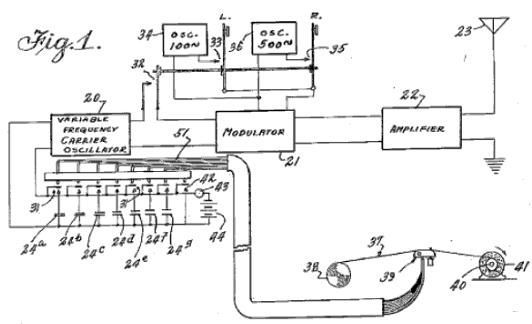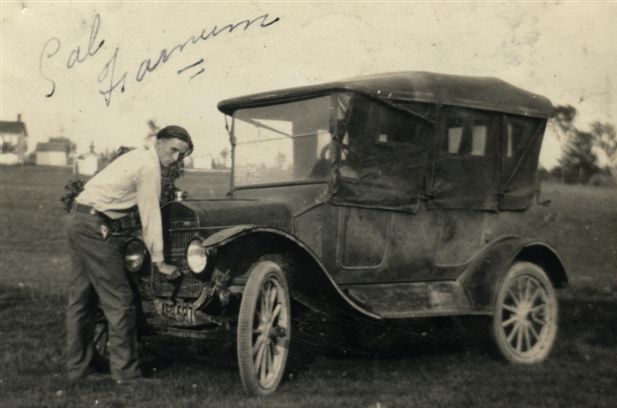The story seems an improbable fiction: a famous Hollywood actress invents a secret technology so far ahead of its time that it takes decades for the full potential of her idea to be recognized. Yet in 1941, actress Hedy Lamarr, collaborating with pianist George Anthiel, invented frequency-hopping, spread-spectrum technology. The concept they pioneered is fundamental to wireless technologies including GPS, WiFi, ultra-wideband (UWB), and cellular communications.
Now Richard Rhodes, Pulitzer Prize-winning author of The Making of the Atomic Bomb, turns his sights on this fascinating story. Rhodes’ Hedy’s Folly: The Life and Breakthrough Inventions of Hedy Lamarr, the Most Beautiful Woman in the World provides a detailed look at the life and times of Hedy Lamarr and her collaborator, pianist George Antheil, with whom she invented a novel frequency-hopping torpedo control system, pioneering what came to be known as “spread-spectrum” technology.

Hedwig Kiesler was born in Vienna, Austria, in 1913. She dropped out of school at age 16 to become a professional actress. She became famous at age 19 for her role in the controversial film, Ecstasy. The film featured a nude swimming scene as well as a sex scene, although that latter scene only depicted the actors’ faces during the act. That same year she married Friedrich Mandl, a Viennese arms merchant who disapproved of his wife’s acting career. He not only tried to acquire all the prints of Ecstasy (at a reported cost of $300,000), but also kept his young wife a virtual prisoner in their home. Hedy entertained business clients and customers of her husband’s arms company, Hirtenberger.
Hedy never specified in detail which German technological advances she heard discussed over luncheons and dinners in the Mandl mansions, but there was much to hear…. Certainly Hedy listened closely to discussions of submarine and aerial torpedos, weapon systems for which Hirtenberger was supplying components. [p. 97]
Hedy spent the winter of 1936-1937 in Switzerland where she struck up a relationship with the novelist Erich Marie Remarque. [pp. 105-106] Rhodes credits Remarque as a guide or mentor for Hedy in her decision to leave her husband. She and Mandl filed for divorce in 1937. Hedy claimed to have disguised herself as her maid in order to escape from her husband and make her way to London. There, she met Louis B. Mayer, head of the MGM Studio. Hedy rebuffed Mayer’s initial offer, but traveled to America on the same liner with Mayer and his wife. After several more discussions, she accepted a seven-year contract with MGM. Mayer insisted, however, that she change her stage name to “Hedy Lamarr,” [reminiscent of actress Barbara La Marr who died of tuberculosis in 1926] at the suggestion of his wife [pp. 109-112].
Hedy Lamarr arrived in Hollywood in October 1937. She worked diligently, learning English, dropping her already slim 125 pounds down to 110, and landing a starring role opposite Charles Boyer in Algiers.
Hedy became a full-fledged Hollywood star. The turbans she wore in the film started a new fashion among American women. Other Hollywood actresses, previously blond, dyed their hair black to match hers, and as she did, began parting it in the middle [p. 115].
Hedy made a few films a year requiring a month or so of shooting each, so she had plenty of time on her hands. She turned to inventing as a hobby.
One way Hedy occupied her spare time was inventing…. “Howard Hughes once lent her a pair of chemists,” Forbes Magazine reports, “to help her develop a bouillon-like cube which, when mixed with water, would create a soft drink similar to Coca-Cola. ‘It was a flop,’ she says with a laugh.” Her daughter, Denise, remembers a tissue-box attachment Hedy invented for disposing of used tissue. Hedy invented to challenge and amuse herself and to bring order to a world she thought chaotic. [p.116]
As the world lurched into war and submarines menaced the Atlantic, Hedy began thinking how to invent a remote control torpedo. That led her into a collaboration. Although Hedy Lamarr headlines Rhodes’ work, his story also delves deeply into the background of her collaborator, pianist and composer George Antheil. The self-proclaimed “Bad Boy of Music,” developed a reputation for his avant-garde compositions. His most notorious work, “Ballet Mècanique,” featured pianos, percussion, electric buzzers and airplane propellers. Here’s a sample:
Antheil attempted (unsuccessfully) to synchronize sixteen player pianos for this work. Eventually, he succeeded in a 1927 Carnegie Hall performance with four synchronized pianos [p. 153]. Antheil necessarily became expert at synchronization and control. He brought these skills to bear in his collaboration with Lamarr.
When Marconi was first asked in 1902 about the application of wireless to warfare he confidently claimed an adversary could never guess the frequency [see RTLS: Direction-Finding Goes to War]. But as early as the First World War, interception, direction finding, and jamming were all part of warfare’s wireless landscape. Signal security in wireless systems was a major concern – how to keep the enemy from figuring out the frequency being used and jam, or worse commandeer, the signal. Hedy may have heard about German efforts to employ multiple frequencies in radio controlled glide bombs at Mandl’s dinner parties, or may have been inspired by a wireless remote control for a Philco radio [p. 144]. A system that can potentially use multiple frequencies is more difficult to jam than one which always uses the same frequency. Hedy took the idea one step farther, however. Instead of a system that operated on one of a number of frequencies, Hedy proposed a system that jumped in a pseudo-random fashion among a set of frequencies, i.e. “frequency-hopping.”
But the challenge in frequency-hopping lies in synchronizing the transmitter and the receiver so that the receiver is listening to the exact same frequency used by the transmitter. That’s where George Antheil’s contribution came in. Antheil took Hedy’s idea and reduced it to practice. He envisioned a paper tape selecting the various RF tones in the frequency-hopping system exactly analogous to the way in which a player piano selects keys to reproduce a desired melody. Starting the two tapes at the same time and running the tapes at the same speed would ensure that both ends of the link remained synchronized. The two received U.S. Patent 2,292,387 for their invention.

Rhodes explains how the system was to work:
Antheil waggishly affirmed a range of up to eighty-eight frequency hops for the system, the number of keys on a piano – a musician’s sly autograph.
With a signal hopping all over the radio spectrum, and doing so not regulalry but arbitrarily, more or less at random, the transmission would be impossible to jam because an enemy would be unable to follow it. He might accidentally jam one frequency if the signal happened to hop there, but with a potential for hundreds of hops per minute, the transmission would lose very little information from such minor interference. Anyone listening on a single frequency would not even realize a signal was being transmitted, since he would hear, at most, only an occasional brief blip.
To make jamming even more difficult, George and Hedy proposed using seven tuning condensers [capacitors] on the transmitter, but only four on the receiver. Three of the transmitter channels would thus send a false signal, one with no operating function, further complicating any effort to determine which transmissions to jam [pp. 173-174].
Unfortunately the Navy’s torpedo program was plagued by technical difficulties. Having difficulty making basic torpedos work reliably, the Navy showed no interest in adopting Lamarr’s and Antheil’s innovative concept [p. 185]. The inventors were hindered by the impression that they were advocating a player piano mechanism be embedded in a torpedo guidance system, instead of that being one specific way to implement the more general concept [p. 152]. Although the Navy formally rejected their idea, it did acquire rights to the patent. The details remain cloaked in secrecy [p. 187-188]. Further, the Navy kept the invention secret for the next forty years.
A decade later, the Navy contracted with Hoffman Laboratories to develop a sonobuoy using Hedy’s and George’s idea, although the project was not ultimately successful [pp. 194-197]. The patent expired, still secret, in 1959. That same year, George Antheil died at age 58, never having any formal recognition of his accomplishment [p. 202].
Rhodes deftly describes the life and times of both Hedy Lamarr and her collaborator, George Antheil. He provides a fascinating discussion of the technical landscape within which their invention took place from hydrogen peroxide torpedo propulsion to radio control and frequency hopping. I was particularly impressed with his clear and cogent discussion of the process of invention and the nature of patents.
Invention is a challenging business. As with Hedy Lamarr’s and George Antheil’s invention of frequency hopping, an idea can be so far ahead of its time as to prevent immediate adoption. Even the greatest ideas can fail if the enabling technology is too immature, the market need is insufficient, or societal forces prevent adoption. A few that come to mind include:
- Hero of Alexandria‘s invention of the steam engine.
- Leonardo‘s helicopter.
- Charles Babbage‘s invention of the computer.
I went looking for more and came across Innovation News Daily’s interesting list that captures two of my three and adds eight more inventions that were ahead of their time. Although Hedy Lamarr never profited from her invention, she did live long enough for her contribution to be recognized in her lifetime. In 1997, the Electronic Frontier Foundation honored the eighty-three year old actress with their Pioneer Award. She died in 2000 at the age of eighty six.
Acknowledgement: Random House was kind enough to send both a bound galley and an early release version of the book. Thanks!
For More Information:
- Robert Scholtz, “Notes on Spread Spectrum History,” IEEE Trans. on Communications, Vol. 31, No. 1, January 1983 [regrettably, behind a pay wall].
- More inventions that were ahead of their time are listed here.
- Last year, ÆtherCzar featured Hedy Lamarr and her invention of frequency hopping technology, although not in the same detail as this present post.
- Also last year, ÆtherCzar hosted a guest post from Kai Siwiak: The Rise and Fall of UWB, placing Lamarr and Antheil’s contributions in context.


3 thoughts on “Review – Hedy’s Folly: The Life and Breakthrough Inventions of Hedy Lamarr”
Looks like Richard Rhodes got the details all right. He interviewed me last year at length at home, since I was the one who nominated Hedy for the Electronic Frontier Foundation Pioneer Award in the first place. Too bad the review did not also mention she got the Kaplan Award – the highest Austrian Academy of Science award, which was, to me, the more prestigious award than the EFF Pioneer Award.
Many thanks for your contributions bringing this fascinating story to light and for seeing that Hedy Lamarr received the recognition she deserved.
It is only coincidental but yet another book is about to be released on Hedy, and the invention, and a movie is in its last stages. The story seems to live on.
If anyone wants to view the entire patent and even hear Hedy’s voice briefly thanking the EFF for the award, they can click on
http://wireless.oldcolo.com/course/hedy.htm which was part of the web site I was required to set up for my 7 years of National Science Foundation research on wireless in the late 90s.
While there are now other ‘unlicensed’ wireless modulations than frequency hopping in use, one is very much used still – Blue Tooth.